 |
Talking to KANETSUKA SENSEI - A conversation with Peter Megann in June 2002by Peter Megann, B.A.F. General Secretary// Источник: B.A.F. Newsletter, Июль 2002, No 42
KS: Well, I didn't used to do Tori-fune until I began to practise under Chiba Sensei (from 1971). There are of course various ways of doing Tori-fune. There is the deep Tori-fune where you stretch forwards and bring your hands down to the tatami, and then there is the small movement which, you remember, Okumura Sensei did when he came to Cardiff in 1986; and there is what we might call the standard Tori-fane, which many Hombu instructors do. I remember that Chiba Sensei told me about the importance of Tori-fune and Kokyu-ho. He said that you could judge the quality of someone's Aikido from seeing them perform these exercises. We perform Tori-fune at the beginning of practice as a form of spiritual cleansing. It helps us to plunge 100% into Aikido once we come into the dojo from outside. And mis is shown in the training
manual (this work, published in 1971 is unfortunately no longer available)
of the late Doshu, "Introduction to Aikido"
PM: So Tori-fune is important because it involves certain basic principles of Aikido movement.
KS: It's often translated as 'boat-rowing' exercise, because it resembles the action of rowing a small boat. As you know, boats in the East are rowed in a way quite different from that in the West, They are propelled by a single oar and the rower faces the front of the boat, rowing and steering the boat at the same time. Another name is
Funa-kogi Undo PM: So, to sum up, the principles of Tori-fune should be incorporated into our Aikido rnovement: moving our centre smoothly, our arms not working independently of our centre* KS: That's right. Our arms are just hanging or
swinging. That's why I do all three kinds: deep Tori-fune, small Tori-fune and the standard Tori-fune. And sometimes I show Tori-fune
swinging the arms to the side. The important
thing is how, with our feet in the right place, we shift our centre of gravity backwards to
forwards or forwards to backwards. A good
example is the solo exercise kokyu-ryoku tenkan-ho
KS: There is a pair of meditational exercises: ama-no tori-fune and
chin kon furi-tama no gyo PM: But it's not just a matter of shaking your hands up and down, is it? KS: Your arms should just be hanging, very relaxed. Your hands make a circular movement - so much of our Aikido movement is circular - from inside to outside. First of all. as we bring our hands up. we make a large circle, than as we shake our hands we make a small circle. It's a little like making a splash in water
KS: Of course, the most basic movements arc omote and ura. When the partner is pulling we do techniques omote with irimi movement, and when he pushes we do them ura with tenkan. This is how we practise them as an exercise; hut in reality it's difficult to do a technique omote and be in a safe situation. In hanmi-handachi katate-dori and ryote-dori shiho-nage we don't have a choice: we have to make irimi or tenkan immediately when there is contact. Impossible to come into sokumen first. You have to protect yourself as you enter. Your foot or knee advances inside, across your partner's front, as you swing your hand up. In a standing situation, the most important thing is to avoid the attack by stepping aside, and at the same time you protect yourself and control your partner - in one movement. So I show both: without sokumen-irimi (even from gyaku-hanmi contact). You can do techniques without stepping aside. But I think this can be dangerous. It's like when a ear is coming towards you: you have to step aside to avoid getting hit. So I usually make one step to the side and from there I make omote or ura. And this makes it easier to do techniques. It's important to attack your partner from an angle, not from the front. PM: So, what you are saying is that sokumen is the safer situation to be in. KS: But sometimes there is no time to step aside, so you have to make a small tenkan. We call it tai-no henko. Not necessarily through 180°: it might even be just about 40°. Simply shift your centre. So from kamae you can take one small step, either into sokumen to the rear side of your partner or with tenshin to the front side. It's important to have the correct ma-ai. PM: So, to sum up: first put yourself in a safe position, able to protect yourself from attack; second make good contact with your partner so as to be able to control him. KS: It's important to deflect the attack, like flicking ii away from you-not pushing. This requires very soft, flexible movement. Your shoulders and arms must be very relaxed. Из словаря
|
||||||||||||||||||||||||||||||||||||
| © Рюсинкан.ру |
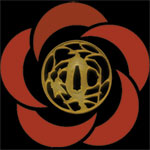
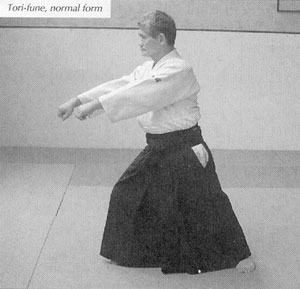 PM: Sensei, it seems to me that over the last few years you have been pulling a lot of emphasis on the Tori-fune ('boat-rowing') exercise and the importance of its movement in Aikido techniques.
PM: Sensei, it seems to me that over the last few years you have been pulling a lot of emphasis on the Tori-fune ('boat-rowing') exercise and the importance of its movement in Aikido techniques.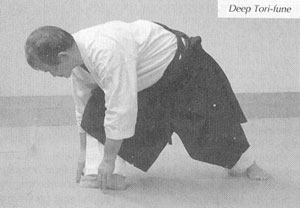 KS: Yes; and I used to think that Tori-fune involved just shifting of our centre of gravity, forwards and backwards. But the movement of your hand (with or without a weapon), whether it is in shomen-uchi, yokomen uchi, kesa-giri, tsuki - anything - must originate from your shoulder. Your shoulder is just like a hinge; then your elbow bends and then your wrist. All these joints must be involved in one movement: one strike or one hand cutting down. We simply swing the arm up and down. And this is particularly the case in deep Tori-fune. It's not a matter of just pushing and pulling with eh-ho, eh-ho. The moment we stop the forward movement, we relax and our elbows and
shoulders drop. This is a very important point. You'll find the same in say Tai-chi Chuan or Karate. In our Aikido techniques how we make contact with our partner, how our stance, our centre, our hand (or hands) are all in the correct position for the situation is very important: and this is all reflected in Tori-fune. We have a phrase in Japanese: shumoku-no ashi. It describes the angle at which someone strikes an Eastern-style bell. In temples in Japan and China a large hanging bell is hit with a tree-trunk which is also suspended and swinging. The person striking the bell must be in correct stance to swing the log and make it strike the bell exactly at right angles. Shu means 'bell', moku means 'wood' and ashi, of course, means 'foot' or 'step'. So your feet must be placed with the front foot directed forwards and the rear foot pointing at right-angles to the forward line. In striking the hell you must move as in Tori-fune, using your whole body.
KS: Yes; and I used to think that Tori-fune involved just shifting of our centre of gravity, forwards and backwards. But the movement of your hand (with or without a weapon), whether it is in shomen-uchi, yokomen uchi, kesa-giri, tsuki - anything - must originate from your shoulder. Your shoulder is just like a hinge; then your elbow bends and then your wrist. All these joints must be involved in one movement: one strike or one hand cutting down. We simply swing the arm up and down. And this is particularly the case in deep Tori-fune. It's not a matter of just pushing and pulling with eh-ho, eh-ho. The moment we stop the forward movement, we relax and our elbows and
shoulders drop. This is a very important point. You'll find the same in say Tai-chi Chuan or Karate. In our Aikido techniques how we make contact with our partner, how our stance, our centre, our hand (or hands) are all in the correct position for the situation is very important: and this is all reflected in Tori-fune. We have a phrase in Japanese: shumoku-no ashi. It describes the angle at which someone strikes an Eastern-style bell. In temples in Japan and China a large hanging bell is hit with a tree-trunk which is also suspended and swinging. The person striking the bell must be in correct stance to swing the log and make it strike the bell exactly at right angles. Shu means 'bell', moku means 'wood' and ashi, of course, means 'foot' or 'step'. So your feet must be placed with the front foot directed forwards and the rear foot pointing at right-angles to the forward line. In striking the hell you must move as in Tori-fune, using your whole body.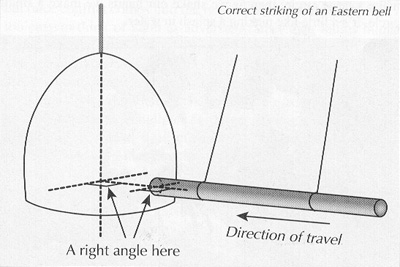 PM: I'm a bit confused about the meaning of Tori-fune. We usually call it the 'boat-rowing exercise'. Why is that?
PM: I'm a bit confused about the meaning of Tori-fune. We usually call it the 'boat-rowing exercise'. Why is that?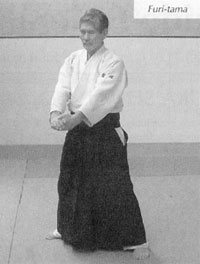 PM: So what can we say about Furi-tama'? What does it mean, and why do we do it following Tori-Fune?
PM: So what can we say about Furi-tama'? What does it mean, and why do we do it following Tori-Fune?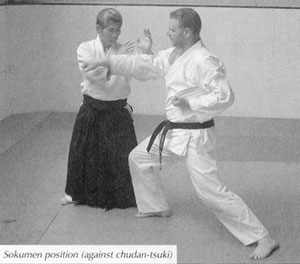 PM: Another thing I wanted to talk to you about is your preference for sokumen as a starting position for techniques.
PM: Another thing I wanted to talk to you about is your preference for sokumen as a starting position for techniques.